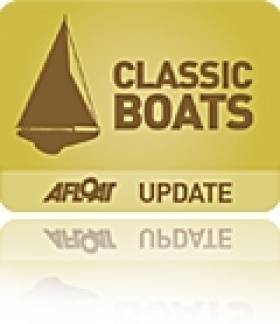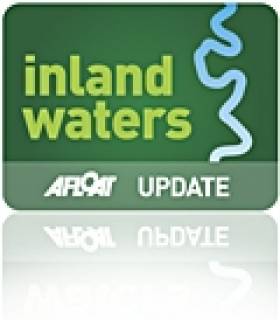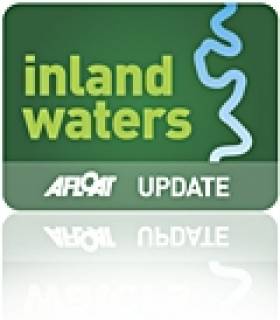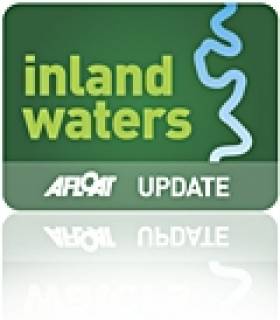Displaying items by tag: restoration
#NaomhÉanna - Afloat.ie previously reported that restoration of the former Aran Islands ferry Naomh Éanna required solid financial backing before a number of ambitious future plans for the boat could proceed.
Now campaigners for the historic vessel have turned to the internet to seek funding for the first step of their rejigged refurbishment plan – now starting with the proposed micro brewery.
Organisers believe that setting up the brewery first – with a funding target of €3,000 for the necessary equipment and licences – will provide the revenue stream needed to get further restoration works in motion, as well as "show investors and banks that we are actually doing something", as the project's IndieGoGo page explains.
It's hoped that the micro brewery will operate from the Naomh Éanna at its Grand Canal Dock berth – and tours of the ship and the proposed brewing facilities are among the perks available for contributors to the crowdfunding campaign, which has 55 days left to go as of Wednesday 20 May.
NI Minister Greenlights Ulster Canal Restoration
#InlandWaterways - NI Environment Minister Alex Attwood has finally announced planning permission to restore part of the historic Ulster Canal that has not been used since 1929.
The original Ulster Canal was completed in 1841 and linked the Erne System to Lough Neagh with a 93km navigation route. It was last used for trading boats in 1929 and officially closed two years later.
The application is to restore 14km of the navigational route in total - 5.5km or river navigation from Quivvy Lough to Gortnacarrow and 8.5km of canal from Gortnacarrow to Clones.
This will involve construction of the existing canal route and tow paths for public access on both banks. New road bridges are to be constructed at Derrykerrib, Wattle Bridge, Gortnacarrow and Clonfad/Munilly with three farm accommodation bridges.
The plan is to restore two existing canal bridges and a double lock at Gortnacarrow that will facilitate a rise from the River Finn to the canal section. A mooring of 170m with 32 car parking spaces and public toilets will be provided at Gortnacarrow. A picnic area and a further 20 parking spaces will be provided at the new bridge at Clonfad/Munilly.
Minister Attwood said: “The Ulster Canal restoration project has been a key heritage and tourist attraction for a long time, which has gathered momentum since the late 90s. Today is a turning point for the project. I hope the Planners’ green light means the project can accelerate.
“This is an example of cross-border initiatives working and working well. It follows from my announcement to give planning permission to the bridge at Narrow Water, linking Warrenpoint and Omeath.
“This cross-border project will be a boost for the people of Fermanagh, Cavan and Monaghan. It will re-open a historic waterway that has not been used for over 80 years and offers huge opportunities for regeneration and leisure-related activities for the entire region.”
Four accompanying applications for Listed Building Consent to carry out works to repair and restore three listed bridges and works to the Clones Aqueduct have also been approved.
Northern Ireland's Department of the Environment consulted Fermanagh District Council on its opinion to approve this application on 18 April 2013.
Monaghan County Council and Clones Town Council have signalled that planning approval should be granted for the Repubic side of the canal - although moves have been slow on that front.
Despite confirmation from Minister for Arts, Heritage and the Gaeltacht Jimmy Deenihan in April 2012 that the "main thrust" of waterways refurbishment is still focused on the reopening of the Ulster Canal, no significant moves have been made in the year since that statement, which came some months after a U-turn in Government funding for such projects.
Minister Has Little to Report on Ulster Canal Project
#INLAND WATERWAYS - Three months on from Minister Jimmy Deenihan's statement on the Ulster Canal regeneration project, and there is little to update on its progress.
As reported on Afloat.ie last December, the Minister for Arts, Heritage and the Gaeltacht replied to a written question from Cork East Sinn Féin deputy Sandra McLennan that the project is "progressing'"despite a U-turn on Government funding, and confirmed that Waterways Ireland would solely fund the scheme from its annual allocations.
However, the minister's latest response - to a question from Cavan-Monaghan Sinn Féin TD Caoimhghín Ó Caoláin requesting an update on the project's progress - is almost identical to his previous statement.
One small difference is an acknowledgement that Cavan County Council has granted planning permission for the project, which involves restoration of the canal between Clones in Co Monaghan and Upper Lough Erne.
Minister Deenihan also stated that his department is "finalising terms of reference" for the proposed inter-agency group that would examine ways to further the project, but gave no timeframe as to when this group would be established.
Minister Opens White River Fishery Enhancement Project
#ANGLING - Minister of State Fergus O'Dowd was on hand at the opening of the White River enhancement project in Dunleer, Co Louth earlier this month.
The €32,000 project was funded by the Louth Leader Partnership, with works were carried out by the Dee and Glyde Fishing Development Association and the Dundalk district staff of Inland Fisheries Ireland.
The White River, a tributary of the River Dee, is considered hugely important as a spawning and nursery area, and it has already seen significant improvements in the levels of juvenile salmon and trout.
Instream enhancement works began in 2006, supervised by Inland Fisheries Ireland, and included the introduction of new gravel, weirs, deflectors and spawning beds which have helped the White River to achieve its potential in terms of fish numbers.
Speaking at the launch, Inland Fisheries Ireland CEO Dr Ciaran Byrne said: "The work that I have seen on the river is fantastic and a credit to all involved."
IFI assistant inspector in Dundalk, Ronan O’Brien, said project was based on restoring the natural features of the river.
He added that the programme was a great recognition of the work carried out by the Dee and Glyde Fishing Association, and that it had strengthened links with local business and development groups and could be used as a template for other projects in the area.
First Phase of Thomastown River Project Complete
#INLAND WATERWAYS - The first phase of a project to restore the Thomastown river was launched at the weekend with the opening of a new weir, the Kilkenny People reports.
Fundraising efforts by the Thomastown Community River Trust have already led to the regeneration of the riverbank from the town up to Thomastown Viaduct.
The new causeway also forms part of a planned trail from Bennettsbridge to Inistioge.
The trust's project was "focused on using environmentally friendly and sustainable engineering", working in partnership "with a diverse range of groups from walkers to kayakers and anglers".
Work is already underway on the second phase that aims to see the restoration of the weir, which collapsed in 2008, as well as the sluice and mill wheel, in an effort to re-establish the swimming pond and fish pass.
The Kilkenny People has more on the story HERE.
Future of Graving Docks in Limbo as Plot 8 is Transferred to NAMA
#INLAND WATERWAYS - The site of the former graving docks at Grand Canal Dock has been transferred to NAMA in a deal which frees the Dublin Docklands Development Authority (DDDA) from a €29 million plus bank guarantee.
Plot 8 at Sir John Rogerson's Quay is one of a suite of nine sites that have been transferred to the Government's 'bad bank' in a negotiated loan settlement that extricates the Docklands body from loan guarantees given by banks that financed the "disastrous" Dublin Glass Bottle site deal in 2006.
Sites handed over in the deal include the former 'U2 Tower' and the historic BJ Marine premises on the banks of the Liffey, as well as the aforementioned Dublin Glass Bottle site.
The Dublin branch of the Inland Waterways Association of Ireland (IWAI) had been hoping to embark on a restoration of the graving docks at Plot 8 to their former working order (a detailed history of the docks and restoration plans is available HERE).
This project had been given the blessing of the DDDA and Waterways Ireland, which owns the freehold lease on the site, with a view to its restoration helping to fund the Ulster Canal scheme.
However with the transfer of the DDDA's interest in the site to NAMA, the authority has now withdrawn permission for the IWAI to do any restoration work, leaving the future of the graving docks in limbo.
Fisheries Funding for Salmon Recovery Projects
Some 17 projects have been approved for funding under the Salmon Conservation Fund, The Irish Times reports.
The pilot scheme by Inland Fisheries Ireland is designed to help angling clubs and fishery owners restore salmon stocks in Ireland's rivers.
The successful applicants across 11 counties will receive a share from more than €120,000 derived from salmon licence-holder contributions.
Accepted projects include spawning enhancement, bank protection, fish passage and habitat improvement. Priority was given to rivers below conservation limits.
The Irish Times has more on the story HERE.




































































